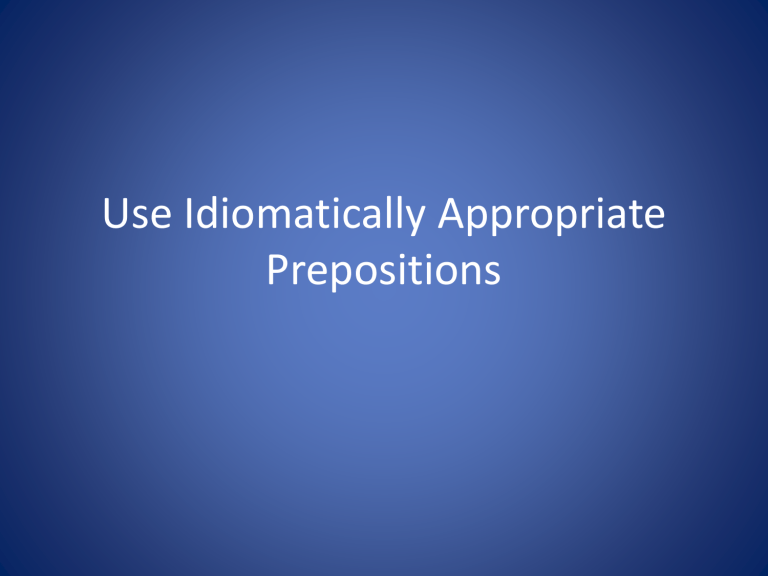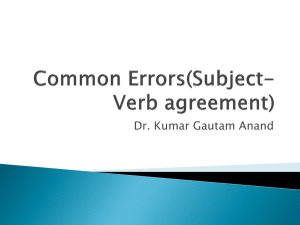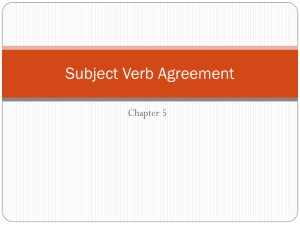Use Idiomatically Appropriate Prepositions

Use Idiomatically Appropriate
Prepositions
What is a preposition?
• Prepositions show relationships between nouns/pronouns and another word in a sentence.
Ex: I took the boat to the lake.
• In the preceding sentence, the word to describes how the boat arrived at the lake.
Prepositions are used to illustrate the how, when, or where of the noun/pronoun in a sentence.
What is an idiom?
• Idioms, or language peculiar to a specific people, region, community, or class, often are used incorrectly.
Ex: We ran across a McDonald’s in Kentucky.
• In the preceding sentence, the idiom is ran across a McDonald’s because we cannot literally run across a McDonald’s.
Correctly Used Prepositions
• Brian was IN the car when the lightning struck.
• Brian was under the car when the lightning struck.
• Brian was on car when the lightning struck.
Example #1
Samantha was so excited about the
brand new bicycle that received for a birthday present that she decided to ride the bike around the block to show all her friends.
A. No Change
B. As
C. In
D. like
Example #1
Samantha was so excited about the
brand new bicycle that received for a birthday present that she decided to ride the bike around the block to show all her friends.
A. No Change
B. As
C. In
D. like
Example #2
The student did not believe the teacher’s explanation of the new rules, so he went over the teacher’s head and asked the principal.
1.
A. No Change
B. Above
C. Under
D. On
Example #2
The student did not believe the teacher’s explanation of the new rules, so he went over the teacher’s head and asked the principal.
1.
A. No Change
B. Above
C. Under
D. On
Suggestions for Using Idiomatic
Prepositions
• Stephanie called up her friends to go to the movies.
• THIS CAN BE CHANGED TO
• Stephanie called her friends to go to the movies.
• Or
The dinner was inside of the refrigerator
• THIS CAN BE CHANGED TO
• The dinner was inside the refrigerator.
Subject-Verb Agreement
• A singlular verb is used with a singular subject.
A plural verb is used with a plural subject.
– EX: Amy wants to go to the mall.
– EX: Students want to skip class.
• When 2 subjects are joined by “and” they become a compound subject, which calls for a plural verb.
– EX: Amy and Mike want to go to the mall after school.
• When 2 singular subjects are joined by “or” or
“nor” they remain singular.
– EX: Either Amy or Mike goes to the mall after school.
• When both singular and plural subjects are joined with “or” or “nor” the verb must agree in number with the subject nearest to it.
– EX: Amy and her sisters go to the mall after school.
– EX: Neither the girls nor Amy goes to the mall after school
– EX: Neither Amy nor the girls go to the mall after school.
Lying on my back in the park last week, I noticed a cloud formation in the sky that looked like a pirate ship. It had a tremendous mast with 2 billowing sails.
The sails, next to the large cannon, was breaking apart as the ship drifted away from me.
A. No Change
B. Were
C. Was not
D. Omit the underlined portion
Lying on my back in the park last week, I noticed a cloud formation in the sky that looked like a pirate ship. It had a tremendous mast with 2 billowing sails.
The sails, next to the large cannon, was breaking apart as the ship drifted away from me.
A. No Change
B. Were
C. Was not
D. Omit the underlined portion
In the debate about nature or nurture being responsible for the actions of serial criminals, one common school of thought believes that a child’s interactions with immediate family members, whether siblings, mother, or father, play a large role in the development of criminal tendencies in that of a child.
A: No Change
B: plays
C: has played
D: are playing
In the debate about nature or nurture being responsible for the actions of serial criminals, one common school of thought believes that a child’s interactions with immediate family members, whether siblings, mother, or father, play a large role in the development of criminal tendencies in that of a child.
A: No Change
B: plays
C: has played
D: are playing











